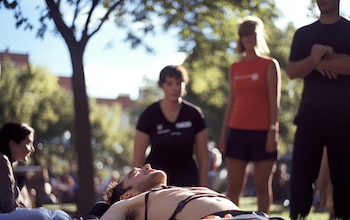
When a person stops breathing or their heart stops, they can be saved by performing cardiopulmonary resuscitation, or CPR. It involves chest compressions and, if trained, rescue breaths to keep blood and oxygen moving until help arrives.
Early CPR can increase the chances of survival by two or even three times after cardiac arrest. The chance of survival decreases significantly with each minute without CPR, making quick action crucial.
Comparing Traditional CPR with Breaths and Hands-Only CPR
For untrained bystanders, hands-only CPR—which only involves chest compressions—is recommended. It is simpler and almost as effective as traditional CPR, which includes rescue breaths.
Remarkable Chest Compressions
Chest compressions are the core of CPR. To perform them effectively:
When to Use Rescue Breaths and How
If trained, add rescue breaths:
Having these skills ensures you are ready to respond appropriately in an emergency.
What Is an AED and How Does it Help?
An Automated External Defibrillator (AED) is a device that can detect abnormal heart rhythms and deliver a shock to restore a normal rhythm. It’s an essential tool that can significantly raise survival rates in cases of cardiac arrest.
How to Use an AED in Easy Steps
AED Location Advice for Public Spaces
AEDs are frequently located in public places like malls, stadiums, and airports. Look for AED location signs and familiarize yourself with their locations in areas you often visit. Quick access to an AED can make a significant difference in an emergency.
Hold a Basic CPR Supply
Keep a small CPR kit with gloves, hand sanitizer, and a mask with you at all times. This ensures you have the necessary tools to safely perform CPR wherever you are.
Make Use of Mobile Apps
Install emergency response apps like Red Cross First Aid or PulsePoint. These apps provide quick access to CPR instructions and the location of the nearest AED, helping you respond effectively in an emergency.
Maintain Your Certification
Keep your CPR certification up to date with regular training. This ensures that your skills are current and that you’re prepared to act confidently in any situation.
Practice Frequently
Schedule regular CPR refreshers. Practicing chest compressions and rescue breaths helps keep your skills sharp and ensures a quick response in emergencies.
Benefit from Free Online Courses
Enroll in free online CPR courses. Websites like SaveaLife.com offer courses that you can complete at your own pace, ensuring you stay updated on the latest CPR techniques at no cost.
Motivate Others to Acquire CPR Training
Encourage friends, family, and coworkers to learn CPR. The more people trained in CPR, the better prepared your community will be to handle emergencies, making a significant impact on public safety.
Emergencies can happen anywhere, at any time, and having CPR training is essential. You can save lives by knowing the fundamentals of CPR, keeping necessary supplies handy, and maintaining your training. Remember, quick action can save lives, so be prepared with the knowledge and confidence you need to act in an emergency. Take a CPR course today and encourage others to do the same, creating a safer and more prepared community for everyone.
Takes 1 minute. No credit card required.